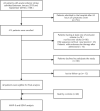Predictive value of longitudinal changes of serum matrix metalloproteinase-9 and brain-derived neurotrophic factor in acute ischemic stroke
- PMID: 36092813
- PMCID: PMC9452807
- DOI: 10.3389/fnagi.2022.952038
Predictive value of longitudinal changes of serum matrix metalloproteinase-9 and brain-derived neurotrophic factor in acute ischemic stroke
Abstract
Background: Matrix metalloproteinase-9 (MMP-9) and brain-derived neurotrophic factor (BDNF) have documented roles in the inflammatory injury cascade of neurovascular units following ischemic brain injury. However, their dynamic changes and predictive values after acute ischemic stroke (AIS) have not been well elucidated.
Objective: To investigate the temporal profiles of serum MMP-9 and BDNF concentrations and their relationship with the prognosis in patients with AIS.
Methods: MMP-9 and BDNF levels were measured in 42 AIS patients in prospectively collected blood samples, which were taken on the first day (Day 1), the second day (Day 2), and the fifth day (Day 5) after admission. Healthy subjects (n = 40) were used as controls. The AIS patients were divided into groups of good functional prognosis (n = 24) and poor prognosis (n = 18) according to their modified Rankin Scale score at 3 months. Longitudinal analysis of MMP-9 and BDNF and their association with neurological prognosis was performed using repeated measurement ANOVA.
Results: At baseline (Day 1), the levels of serum MMP-9 and BDNF were significantly higher in the AIS group than in the normal control group (P < 0.01). Repeated measurement ANOVA showed a significant main effect and interaction of MMP-9 between good prognosis and the poor group (P < 0.05). Further simple-effect analysis showed that the MMP-9 level was significantly increased in the poor prognosis group compared with the good prognosis group at T5 (P < 0.05). There were no significant time-dependent or the interaction effect (all P > 0.05), but a main effect (P < 0.05) for BDNF. Compared with the poor prognosis group, the simple-effect results indicated that the BDNF level of the good prognosis group was lower at Day 1, while the same was reversed for expression at Day 5 (P < 0.05).
Conclusion: MMP-9 and BDNF are closely related to the prognosis of patients with AIS in a time-dependent manner. The dynamic changes of the two biomarkers are superior to baseline levels in predicting the prognosis of AIS patients. A sustained decrease in MMP-9 and an increase in BDNF levels in AIS patients after several days of treatment implied a favourable prognosis.
Keywords: acute ischemic stroke; brain-derived neurotrophic factor; matrix metalloproteinase-9; neuroinflammation; serum biomarkers.
Copyright © 2022 Li, Han, Luo, Huang, Huang, Li, Huang, Chen and Wu.
Conflict of interest statement
The authors declare that the research was conducted in the absence of any commercial or financial relationships that could be construed as a potential conflict of interest.
Figures




Similar articles
-
Low Concentration of BDNF in the Acute Phase of Ischemic Stroke as a Factor in Poor Prognosis in Terms of Functional Status of Patients.Med Sci Monit. 2015 Dec 14;21:3900-5. doi: 10.12659/msm.895358. Med Sci Monit. 2015. PMID: 26656843 Free PMC article.
-
Low Circulating Acute Brain-Derived Neurotrophic Factor Levels Are Associated With Poor Long-Term Functional Outcome After Ischemic Stroke.Stroke. 2016 Jul;47(7):1943-5. doi: 10.1161/STROKEAHA.115.012383. Epub 2016 Jun 14. Stroke. 2016. PMID: 27301948
-
[A panel of serum biomarkers, including damage, apoptosis and neurotrophic markers, for the assessment of prognosis of the course of ischemic stroke].Zh Nevrol Psikhiatr Im S S Korsakova. 2022;122(8. Vyp. 2):48-53. doi: 10.17116/jnevro202212208248. Zh Nevrol Psikhiatr Im S S Korsakova. 2022. PMID: 36036143 Russian.
-
Biomarkers in the Prediction of Hemorrhagic Transformation in Acute Stroke: A Systematic Review and Meta-Analysis.Cerebrovasc Dis. 2022;51(2):235-247. doi: 10.1159/000518570. Epub 2021 Sep 22. Cerebrovasc Dis. 2022. PMID: 34569521
-
Decreased Serum Brain-Derived Neurotrophic Factor May Indicate the Development of Poststroke Depression in Patients with Acute Ischemic Stroke: A Meta-Analysis.J Stroke Cerebrovasc Dis. 2018 Mar;27(3):709-715. doi: 10.1016/j.jstrokecerebrovasdis.2017.10.003. Epub 2017 Nov 8. J Stroke Cerebrovasc Dis. 2018. PMID: 29128330 Review.
Cited by
-
The multifaceted roles of activating transcription factor 3 (ATF3) in inflammatory responses - Potential target to regulate neuroinflammation in acute brain injury.J Cereb Blood Flow Metab. 2023 Nov;43(2_suppl):8-17. doi: 10.1177/0271678X231171999. Epub 2023 May 11. J Cereb Blood Flow Metab. 2023. PMID: 37165649 Free PMC article. Review.
-
Circulating Serum VEGF, IGF-1 and MMP-9 and Expression of Their Genes as Potential Prognostic Markers of Recovery in Post-Stroke Rehabilitation-A Prospective Observational Study.Brain Sci. 2023 May 23;13(6):846. doi: 10.3390/brainsci13060846. Brain Sci. 2023. PMID: 37371326 Free PMC article.
-
Blood-based protein biomarkers during the acute ischemic stroke treatment window: a systematic review.Front Neurol. 2024 Jul 18;15:1411307. doi: 10.3389/fneur.2024.1411307. eCollection 2024. Front Neurol. 2024. PMID: 39091977 Free PMC article.
-
The role of neutrophils in tPA thrombolysis after stroke: a malicious troublemaker.Front Immunol. 2024 Nov 13;15:1477669. doi: 10.3389/fimmu.2024.1477669. eCollection 2024. Front Immunol. 2024. PMID: 39606238 Free PMC article. Review.
-
A Short Review on Advances in Early Diagnosis and Treatment of Ischemic Stroke.Galen Med J. 2023 Aug 21;12:e2993. doi: 10.31661/gmj.v12i0.2993. eCollection 2023. Galen Med J. 2023. PMID: 39430040 Free PMC article. Review.
References
-
- Adams H. P., Bendixen B. H., Kappelle L. J., Biller J., Love B. B., Gordon D. L., et al. (1993). Classification of subtype of acute ischemic stroke. Definitions for use in a multicenter clinical trial. Toast. Trial of Org 10172 in acute stroke treatment. Stroke 24 35–41. 10.1161/01.str.24.1.35 - DOI - PubMed
-
- Barkho B. Z., Munoz A. E., Li X., Li L., Cunningham L. A., Zhao X. (2008). Endogenous matrix metalloproteinase (Mmp)-3 and Mmp-9 promote the differentiation and migration of adult neural progenitor cells in response to chemokines. Stem Cells 26 3139–3149. 10.1634/stemcells.2008-0519 - DOI - PMC - PubMed
-
- Bramham C. R., Messaoudi E. (2005). BDNF function in adult synaptic plasticity: The synaptic consolidation hypothesis. Prog. Neurobiol. 76 99–125. - PubMed
LinkOut - more resources
Full Text Sources
Miscellaneous

